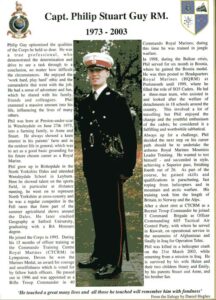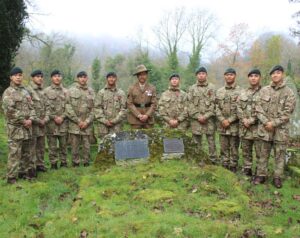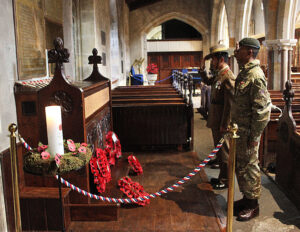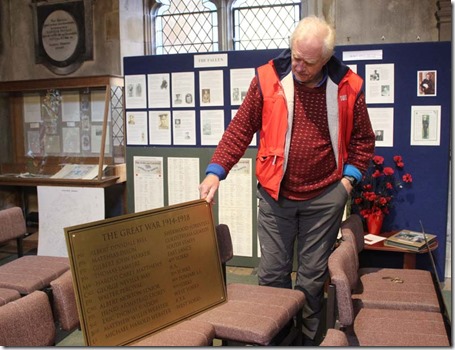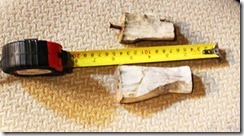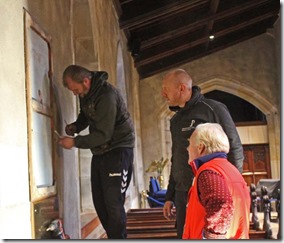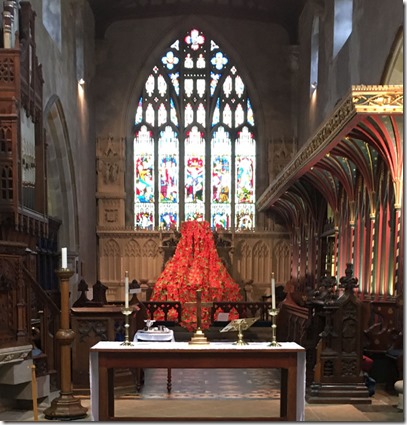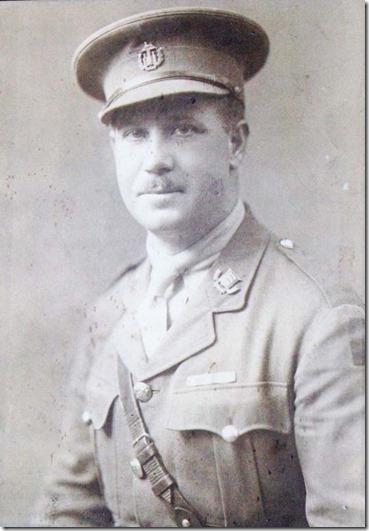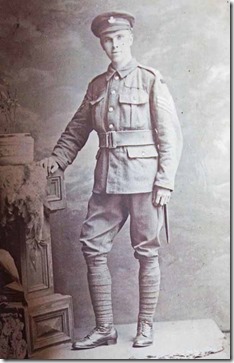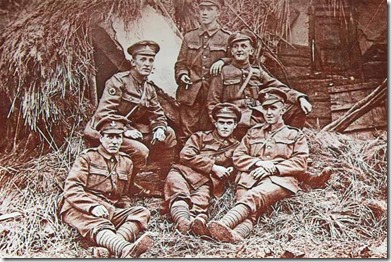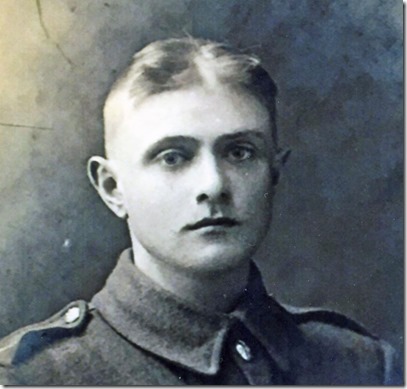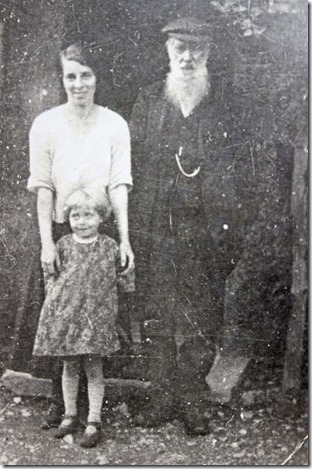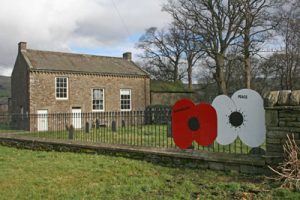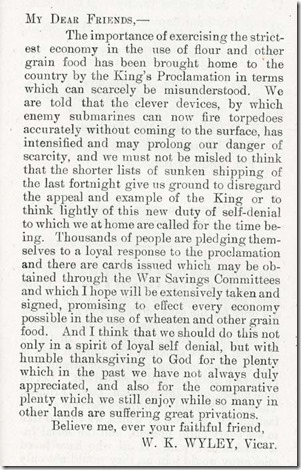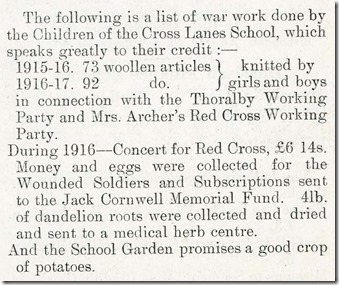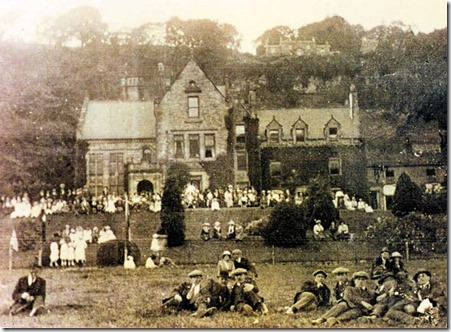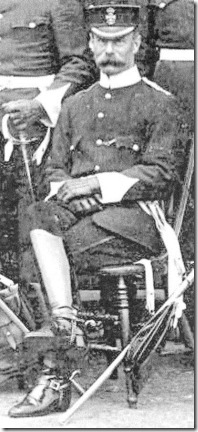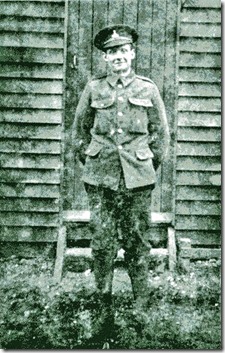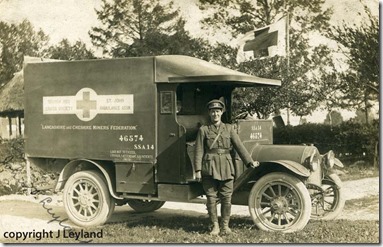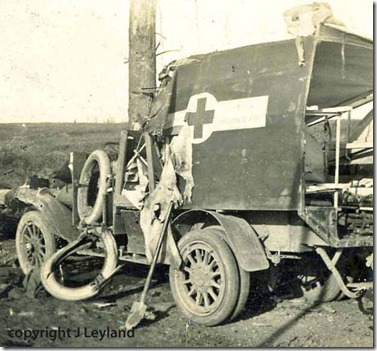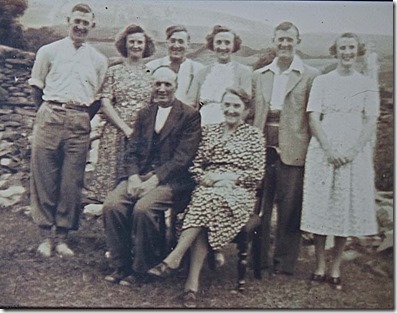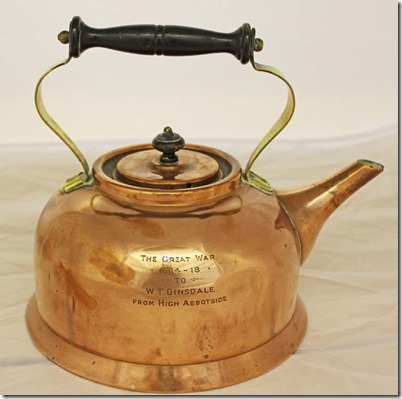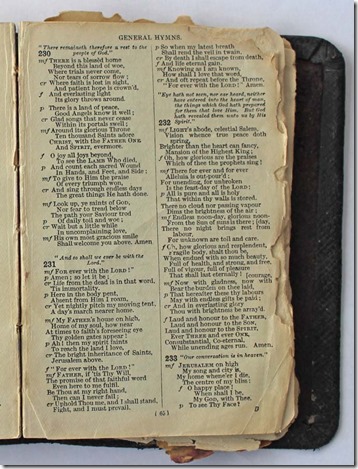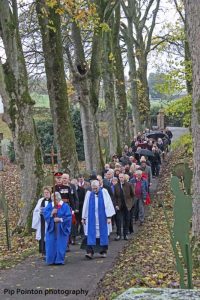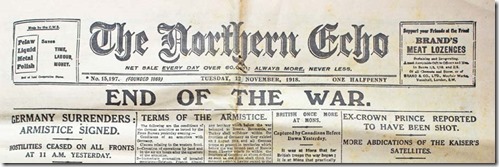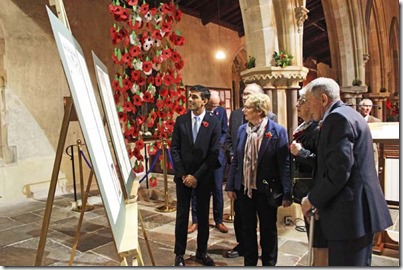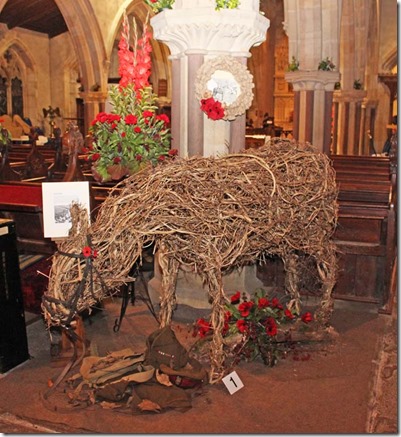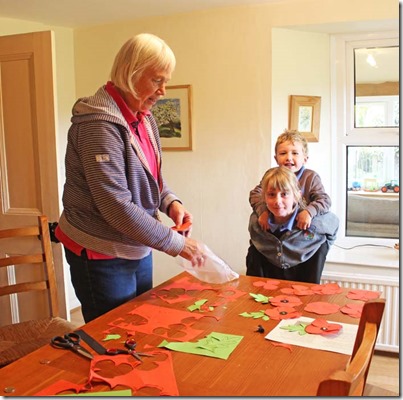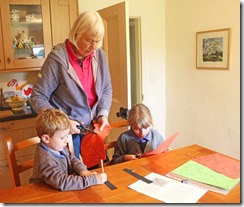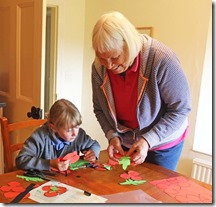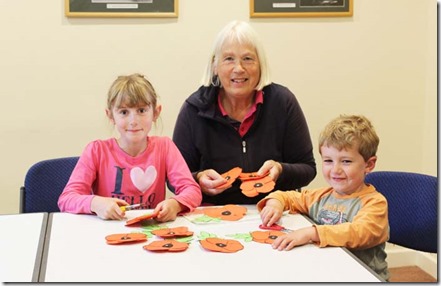Men from Aysgarth parish killed during the 1st World War:
The following are listed on the plaques in the church
Pte Albert Dinsdale Bell, Sherwood Foresters
Pte James Bell, Cameron Highlanders
Pte Harold Binks, 13th Yorks
Pte William Edward Bushby Croix de Guerre, 20th D.L.I.
Pte George Charlton, R.A.S.C.
Pte Mattias Dixon, Coldstream Guards
Pte James Bell Fawcett, 8th Yorks
Pte John Mills Gould, 17th North LD Fusrs
Pte George Sidney Gould, Canadian E.F.
Pte George Iveson Hammond, 4th Yorks
Pte Gilbert John Harker, South Staffs
Pte William Hemsley, 10th West Yorks
Pte Matthew Heseltine, Green Howards
Pte Matthew Heseltine, Green Howards (cousins, killed on same day)
Pte William Herbert Kilburn, 3rd Yorks
Pte Thomas Lambert, East Lancs
Col. John William Lodge, 3rd Yorks
Maj Harold Carey Matthews, 4th Yorks
Pte Arthur Mawer, R.A.S.C.
Capt George Neville May, R.A.
Pte Robert Pickering Metcalfe, 8th K.R.R.C
Capt Albert Morton, 9th Punjabi L.I.
Pte John Percival, 9th Yorks
Pte Timothy Percival, R.F.A.
Pte Walter Percival, Yorkshire Hussars
Cpl Joseph Dixon Raw M.M., 3rd Yorks
L/Cpl John Shannon, 10th Yorks
Pte Henry Armistead Storey, 9th Yorks
Pte Thomas Spence, 4th Yorks
Sgt Eric Thomas Watson, West Yorkshire
Bdr Matthew Willis Webster, RFA
Lt Michael Harold Webster, West Yorkshire
There are also plaques remembering:
Men from Aysgarth parish killed during the 2nd World War:
L/Cpl Francis John Chapman, Durham L.I.
Sgt Thomas Foster, Grenadier Guards
A/C Frederick William Lawson, R.A.F.V.R.
Pte Alan Louis Smith, Border Regt.
Killed during the 1st Iraq War
Capt Philip Stuart Guy, Royal Marines (see bottom of post for details)
Remembered in the churchyard
Twenty-one soldiers from World War One and World War Two are remembered in the churchyard at Aysgarth church with the majority being on family memorials. Those remembered in the churchyard are:
Pte Harold Binks d 1918
Pte William Edmund Bushby Croix de Guerre d 1918
Pte Francis John Chapman d 1941
Pte John Mills Gould d 1915
Pte George Sydney Gould d 1916
Pte George Iveson Hammond d 1916
Pte Gilbert John Harker d 1915
Cpl William Hemsley d 1917
Pte Matthew Heseltine of Thoralby d 1916
Pte Matthew Heseltine of Newbiggin d 1916
RAFVR Frederick William Lawson d 1941
Col John William Lodge d 1917
Major Harold Carey Matthews d 1915
Rifleman Robert Pickering Metcalfe d 1917
Pte John Percival d 1918
Lance Cpl John Shannon d 1916
Pte Alan Lewis Smith d 1944
Pte Thomas Spence d 1919
Sgt Eric Thomas Watson d 1916
Bdr Matthew Willis Webster d 1916
Lt Michael Harold Webster d 1918
FIRST WORLD WAR
Much of the information and many of the photos are from Wensleydale Remembered and reproduced with the kind permission of the author, Keith Taylor.
Honoured for their bravery
During World War One two from Aysgarth parish received medals for bravery but later were killed in battle.
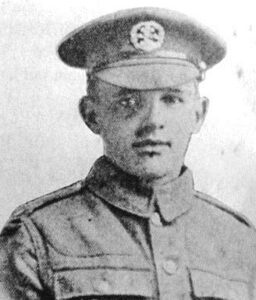 Pte William Edmund Bushby from West Burton was, with his commanding officer and four other men, awarded the Croix de Guerre by the French for bravery in the field of battle.
Pte William Edmund Bushby from West Burton was, with his commanding officer and four other men, awarded the Croix de Guerre by the French for bravery in the field of battle.
He was 19-years-old when he was killed during a German attack near Kerkhove in Belgium, which included mustard and tear gas – just nine days before the Armistice on 11 November 1918. He was buried at the Vichte Cemetery east of Courtrai in Belgium.
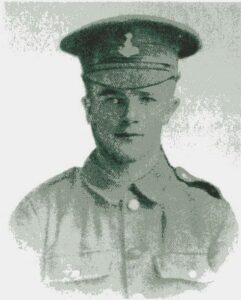 Pte Joseph Dixon Raw was twice recommended for distinction and in April 1918 was awarded the Military Medal for gallantry at St Quentin between March 21 and March 28 that year.
Pte Joseph Dixon Raw was twice recommended for distinction and in April 1918 was awarded the Military Medal for gallantry at St Quentin between March 21 and March 28 that year.
He died, aged 21, in the Ypres Salient on May 8, 1918, and is commemorated on the Tyne Cot Memorial near Ypres.
Remembered at Thiepval
The largest Memorial to the Missing of World War One is at Thiepval in France. The names on it include that of Lance Cpl John Shannon one of the five Wensleydale men killed on the first day that infantry were involved in the Battle of the Somme 1 July 1916. His parents had moved to Carperby in 1893.
Two cousins from Bishopdale are remembered at Thiepval because their bodies were never recovered. Both were called Matthew Heseltine– they joined the 6th Battalion Yorkshire Regiment together and died on the same day: Thursday 14 September 1916.
Pte Heseltine from Swinacote, Thoralby (below) was 22 when he died and his cousin was 21.


Pte George Iveson Hammond (19) (above) from West Burton and Pte (William) Herbert Kilburn (20) from Carperby were buried at Mill Road Cemetery, Thiepval.
They both killed by machine-gun fire on Sunday 3 September 1916. Their battalion’s total casualties that day were 11 officers and 336 men killed or wounded out of 18 officers and 629 men.
Commemorated in Belgium
Tyne Cot Memorial
Rifleman Robert Pickering Metcalfe was the first from Thornton Rust to die during that war. He was killed by a shell burst when attacking an enemy trench on 24 August 1917 aged 24. His captain wrote, in a letter to his mother Grace, ‘Your son has done extremely good work out here as a Lewis gunner…’
 Both he and Cpl William Hemsley are commemorated on the same panel of the Tyne Cot Memorial following the Battle of Passchendaele (Third Battle of Ypres).
Both he and Cpl William Hemsley are commemorated on the same panel of the Tyne Cot Memorial following the Battle of Passchendaele (Third Battle of Ypres).
Cpl William Hemsley (19) (left) from Thoralby and Pte Nathan Burton Iveson (29) from Gayle, died on 4 October 1917 during an intense 21-hour bombardment of their battalion’s position.
The 10th Battalion Yorkshire Regiment held on but suffered serious losses. It was reported that the trench conditions were terrible with men standing in over a foot of slime.
Menin Gate
Pte James Bell Fawcett, a farmer from Bishopdale, was 38-years-old when he was killed by a shell burst on 7 June 1917 and his body was never recovered. He is remembered on Panel 33 on the Menin Gate.
Commemorated in France
Arras Memorial
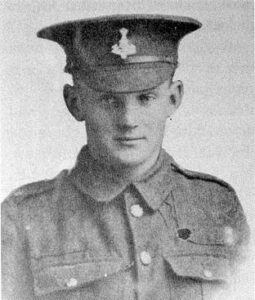 Pte Harold Binks was born in Well near Masham but was living in West Burton when he enlisted at Leyburn in 1915. He was 23 when he was killed on 22 March 1918 in a battle between Arras and Bapaume.
Pte Harold Binks was born in Well near Masham but was living in West Burton when he enlisted at Leyburn in 1915. He was 23 when he was killed on 22 March 1918 in a battle between Arras and Bapaume.
Vimy Memorial
Pte James Pickard Bell (below) was born in Aysgarth and returned to the village after graduating from Leeds Boys Modern School. In 1910, when he was 22, he emigrated to Canada to farm on the prairies of Manitoba.
In 1915 he enlisted with the 79th Battalion Cameron Highlanders, a Canadian Scottish Regiment. His battalion was sent to France in February 1916. On 4 October 1916, during the later stages of the Battle of the Somme, Pte Bell was seen leading a section of the bombers towards the German lines. Later he was reported ‘missing presumed dead’. His body was never recovered.

Buried in France
Trooper Arthur Mawer (below) was a farm worker at West Burton when he enlisted at Richmond in August 1914. As he was used to working with horses he joined the 1st Lifeguard, Household Calvary. In France they joined the infantry in the trenches in the Ypres Salient. He was wounded in both legs on 27 January 1916, and died on February 11 aged 20. He was buried at Calais Southern Cemetery.

Gunner Timothy Percival from Carperby saw action with a trench mortar battery throughout 1917 and most of 1918, but was wounded just a few weeks before the war ended. He then became ill with pneumonia and died on 16 November 1918 aged 28. He was buried at Cambrai East Military Cemetery in France.
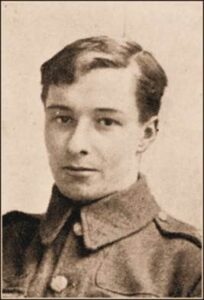 Pte Albert Dinsdale Bell spent his early years in Thoralby until the family moved to Steeton-with-Eastburn near Bradford.
Pte Albert Dinsdale Bell spent his early years in Thoralby until the family moved to Steeton-with-Eastburn near Bradford.
He enlisted with the Sherwood Foresters, Nottingham and Derbyshire Regiment.
On 8 August 1917, a month before his 22nd birthday, he was killed on the Western Front while acting as a messenger. He was buried in Sunken Road Cemetery at Fampouxi.
(Information and photo courtesy of Craven’s Part in the Great War)
Pte Thomas Lambert was born in Aysgarth in 1892. His family later moved to Accrington in Lancashire where he worked as a brass glazier in a factory. He became one of the Accrington Pals when he enlisted with the 11th Battalion E Lancashire Regiment. He was killed on 1 July 1916 and is commemorated in The Queen’s Cemetery at Puisieux.

When Captain George Neville May died of his wounds at Rouen on 29 May 1918 aged 34 his daughter, Pamela Castilla (at home with her mother at Thornton Hall, Thornton Rust) was just 24 days old.
Capt May was born in Brighton and in 1910 married Violet Castilla Matthews of Hawes.
He was with the 343rd Siege Battery, Royal Garrison Artillery when he was fatally wounded during action near Doullens and died three days later. He was buried in St Sever Cemetery, Rouen.
(Information from Craven’s Part in the Great War and De Ruvigny’s Roll of Honour)

Pte Walter L Percival spent the first few years of his life on his father’s farm at Thornton Rust until his parents moved their family to Leeds probably for better job prospects.
Walter enlisted at Leeds into the 1st/5th Battalion, Yorkshire Regiment. While serving in France he was captured and died of dysentery aged 19 whilst a prisoner of war.
He was buried at Sissone British Cemetery, Aisne, Picardie Region, France.
(Information from Thoralby Through Time. Photo courtesy IWM)
Pte Henry Armistead Storey is commemorated on the village war memorial in the centre of Carperby village as he had worked on a local farm prior to enlisting with the 9th Battalion Yorkshire Regiment.
He was born into a farming family at Downholme. His parents, Fred and Maria Storey, later moved to Bardin Lane Farm near Constable Burton.
Between 5 and 10 July 1916 during the Battle of the Somme Pte Storey’s battalion suffered heavy losses with 438 men killed, wounded or missing. Pte Storey was wounded by shell fire and died in a Field Ambulance Station on 2 August.
He was buried in Albert Communal Cemetery Extension. His fiancée in Carperby never married and became the village postmistress.
Buried at Aysgarth
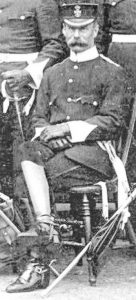 The biggest military funeral at Aysgarth church during WW1 was that for Col John William Lodge with the band of his regiment and the detachments of two battalions being present. The firing party fired volleys over his grave and buglers sounded the Last Post. He was 60-years-old when, on leave at his home at The Rookery in Bishopdale, he died on 23 August 1917, after a short illness.
The biggest military funeral at Aysgarth church during WW1 was that for Col John William Lodge with the band of his regiment and the detachments of two battalions being present. The firing party fired volleys over his grave and buglers sounded the Last Post. He was 60-years-old when, on leave at his home at The Rookery in Bishopdale, he died on 23 August 1917, after a short illness.
He had served in the Boer War and from 1906-1912 had commanded the 3rd Battalion of the Yorkshire Regiment. At the outbreak of the 1st World War he had immediately returned to the battalion as a major and in May 1916 was appointed to the command of a Garrison Battalion.
When Pte John Mills Gould was buried at Aysgarth four days after he died on 9 April 1915 aged 26 almost all the residents from Bishopdale were there as well as 16 of his comrade soldiers. The soldiers fired three volleys over his grave and a bugler played the last post.
He had worked at Ferrybridge as a railway clerk prior to enlisting in the E Company of 17th Northumberland Fusiliers. He had returned to Ferrybridge to visit a friend when he fell ill and died of pneumonia and pleurisy.
Two years later his youngest brother, Pte George Sidney Gould, was killed while attacking the Germans on Vimy Ridge on 9 April 1917 aged 26. In 1914 he had emigrated to Canada but had later joined the Canadian Expeditionary Force,
The Gould family at that time lived at Warnford Court in Bishopdale.
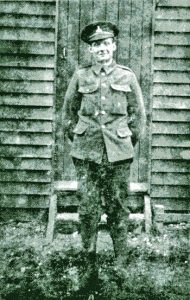 There wasn’t a military funeral for Pte John Percival but there is a military gravestone. He was 21-years-old when he died and was buried on 12 April 1918.
There wasn’t a military funeral for Pte John Percival but there is a military gravestone. He was 21-years-old when he died and was buried on 12 April 1918.
This obituary was published about him:
‘He enlisted when he was 19, and after being trained at Rugeley Camp, went to France in April 1916, and was through the battle of the Somme, being badly wounded in the hand in September 1916. He was sent back to England for treatment, and made a sufficient recovery to enable him to return to service.
‘As he was a competent motor driver he was transferred by the authorities from the Yorkshire Regiment to the Motor Transport, Army Service Corps, in June 1917. In this work he did good service until October last, when he was badly gassed, and was seriously ill. He returned to England, and was in the 1st London General Hospital, Camberwell, until November 27th, when he was officially discharged from the Army as physically unfit for further service.
‘A relative went to London to bring him home. He was very weak, and while crossing London an air raid was proceeding, and the journey was several times interrupted. Arrived at Aysgarth he was very happy to see his home and family, and seemed to revive for a while, but the gas had seriously damaged his lungs and recovery was seen to be impossible.
‘Though relatives and friends nursed him tenderly day and night there was no progress towards health. The funeral was largely attended by sympathising friends, and some beautiful wreaths and affectionate messages were sent.’
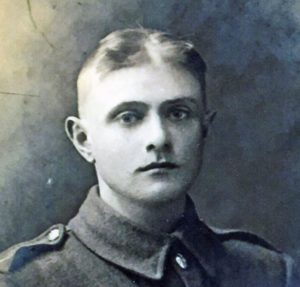
Pte Thomas Spence was invalided home in early 1916 having been gassed during the Battle of the Somme. He received an honourable discharge from the 4th Brigade Yorkshire Regiment (Green Howards) in August that year.
He returned to his family in Walden and got married. But in April 1919 he caught Spanish Flu and died aged 23. four months before his baby daughter was born.
for more see Pte Thomas Spence
Buried in Belgium
Pte Gilbert John (Jack) Harker was included on the memorial in Carperby village because most of his aunts and uncles were living there. His grandmother, Nancy Harker, had farmed within the parish.
His father’s work as a railway clerk had taken him to Leeds and later to Birmingham. So it was at Handsworth that Jack enlisted with the 1st/5th Battalion South Staffordshire Regiment.
After defending trenches in the Ypres Salient during July 1915 the Battalion went into Brigade Reserve at Railway Dugouts in early August. On 6 August Pte Harker (21) was killed by an exploding shell whilst helping a Royal Engineers’ working party. He was buried in the Royal Dugouts Burial Ground. (Wensleydale Remembered)
Major Harold Carey Matthews (born in Hawes) had served in the Boer War as a 2nd Lieutenant with the 4th Yorkshire Regiment and received the Queen’s medal with five clasps.
He volunteered for foreign service when war broke out in 1914 and was gazetted as a major. His regiment left for France on 17 April 1915 and he was killed in action at St Julien north of Ypres eight days later on his 36th birthday.
He was buried at the Sanctuary Wood Cemetery in Belgium. He is also remembered on his parents’ headstone in Aysgarth churchyard. His second child, a daughter, was born in October 1915. (Information from De Ruvigny’s Roll of Honour)
Pte Matthias Dixon was born in Walden and by the beginning of the war was his father’s right hand man at the Grange, a farm between Buckden and Hubberholme.
In his spare time he was a chorister and bell ringer at Hubberholme Church.
He enlisted with the Coldstream Guards at Skipton on 15 August 1916. Six months later they were in the Ypres Salient.
By late July the regiment had suffered such heavy casualties that it had no volume of rifle fire.
On 1 August it rained heavily and the trenches were ditches of water with everyone standing in water up to their thighs and terribly cold. Pte Dixon (25) was wounded that day and died of his wounds. He was buried at Dozinghem Military Cemetery.
Those who crowded into Hubberholme church for his memorial service heard the vicar (the Rev R F R Anderton) read letters from senior officers about Pte Dixon, praising his bravery and how he had not lost heart even in the most trying conditions.
(Photo courtesy Craven Herald, information from Swaledale & Wharfedale Remembered by Keith Taylor.)
Buried in Iraq
The parents of Captain Albert Morton Senior moved to Carperby after his father, Colonel H W J Senior, retired from the Indian Cavalry. Their son also joined the army and by August 1914 was a Captain.
He was with the 9th Punjabi Light Infantry when it was one of two Indian Divisions sent to try and relieve General Charles Townshend’s Division which was besieged by the Turkish Army at Kut in what is now Iraq from December 1915. The Turkish defences, however, were so strong that all the attacks during March and early April were repulsed with heavy losses. Captain Senior was wounded and died on 22 April 1916. He is commemorated on the Basra Memorial in Iraq.
General Townshend was forced to surrender on 29 April 2016. This was one of the most crushing defeats experienced by the British Army with 23,000 British and Indian lives being lost either in Kut or in the attempt to break the siege. Those of the 2nd Battalion 8th Gurkhas were among the 8,000 troops taken into captivity during which about half died. Lt Col Alban Wilson was among those who recovered control of Kut – (See Aysgarth church and a Gurkha officer )
Buried in Co Durham
Prior to the war Pte George Charlton had moved from his family home in Crawcrook, Co. Durham, to work as a farm servant for John Chapman at Thornton Hall, Thornton Rust. He served abroad with the Army Service Corps before being transferred to the 5th Reserve Cavalry Regiment in England. It is understood he died of pneumonia on 2 December 1918 aged 25. He was buried in St John’s Churchyard, Greenside, Co. Durham. (Sources: Wensleydale Remembered, John Richardson and Thoralby Through Time)
SECOND WORLD WAR
Pte Francis Chapman was born in Thornton Rust and became Master of the Wensleydale Harriers in 1931. He enlisted with the 16th Battalion Durham Light Infantry and was killed in a road accident on October 8,1941, aged 31. He is buried in Aysgarth churchyard.
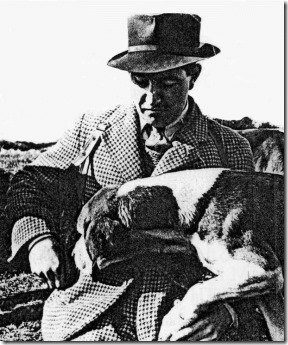
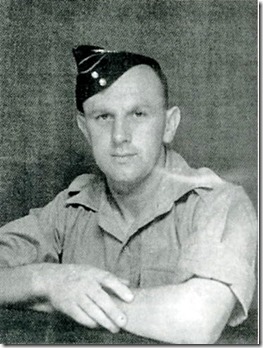
Pte Alan Smith of the 9th Battalion Border Regiment (above right )was killed in action in Burma on May 14, 1944 aged 27. He was buried at Imphal War Cemetery, NE India. Before the war he and his father worked as gardeners in West Burton and Alan was also a trainee local Methodist preacher.
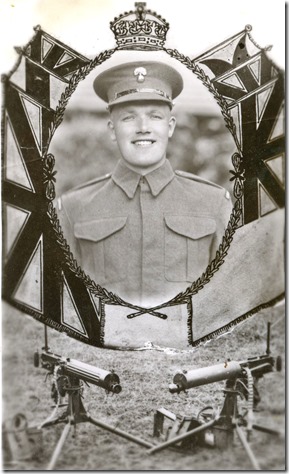
Sgt Tom Foster: Although Tom and James Foster of Thoresby near Carperby were listed as being in the important reserved occupation of farming during the 2nd World War they still joined the armed forces. Tom rose to the rank of sergeant in the 5th Battalion Grenadier Guards and James served with the Guards Armoured Division and took part in D Day 2.
Tom’s battalion was sent to Tunisia in early 1943 and the 5th Grenadier Guards were among those who attacked the Germans at Tunis. Tom was killed on April 29 and was buried at the Medjez-el-Bab war cemetery in Tunisia. Prior to embarkation Sgt Foster had instructed soldiers on the use of the bren-gun carrier.
Aysgarth church was full for his memorial service in 1943. A memorial stone to him at Carperby was unveiled in June 1946.
Above: the memorial photograph that Tom’s family received.
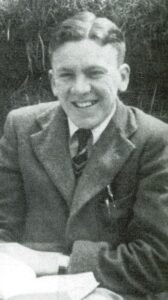 Aircraftman Second Class Frederick ‘Freddie’ Lawson : His father, William, ran the general store and post office in West Burton. After graduating from Yorebridge Grammar School Freddie gained a degree in English at Leeds University. He was working as a teacher at Richmond Methodist School when he volunteered to join the RAF in 1939.
Aircraftman Second Class Frederick ‘Freddie’ Lawson : His father, William, ran the general store and post office in West Burton. After graduating from Yorebridge Grammar School Freddie gained a degree in English at Leeds University. He was working as a teacher at Richmond Methodist School when he volunteered to join the RAF in 1939.
Freddie was training to be an air-gunner on bombers when he was killed in a night time traffic accident at Dishforth on October 16, 1941 aged 25. He is buried in the south west part of Aysgarth churchyard.
Died at Wassett Fell, Bishopdale
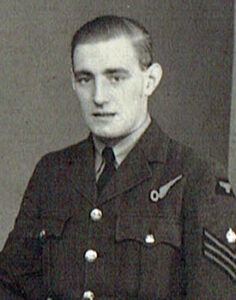 On the night of 15th/16th January 1942 a Hampden Mk.1 bomber (AE393) was heading back to its base at Balderton, Nottinghamshire after a raid on Hamburg when it crashed on Wassett Fell, Bishopdale. One of the crew who died was the 21-year-old navigator, Flight Sergeant James Arthur Bunting.
On the night of 15th/16th January 1942 a Hampden Mk.1 bomber (AE393) was heading back to its base at Balderton, Nottinghamshire after a raid on Hamburg when it crashed on Wassett Fell, Bishopdale. One of the crew who died was the 21-year-old navigator, Flight Sergeant James Arthur Bunting.
The weather that night was bad and many crews struggled to make safe landings. An investigation concluded that the altimeter of A393 was probably incorrect as, just before impact, it read 5,000ft.
James was born in Otley in 1920 and was the son of Charlie and Phyllis Bunting. He began his operational flying with 49 Squadron in December 1939 and by September 1940 he had flown 40 operational flights. After a spell with 14 OTU he was posted to 408 Squadron to fly operationally again. He is buried at Otley Cemetery.
With thanks to his nephew, the late Mr D Crossley and to www.yorkshire-aircraft.
(Information and photos courtesy Wensleydale Remembered unless otherwise stated. Also see 1st World War section of www.thoralbythroughtime)
1st Iraq War
